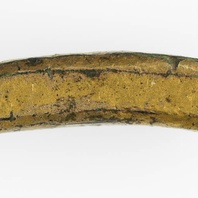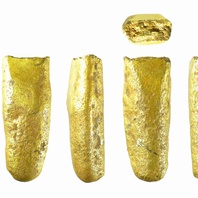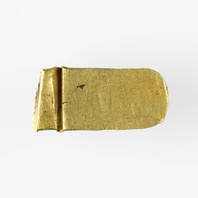
Viking Objects
Forged Hack-gold Rod (CM 595-2010)
This forged hack-gold rod comprises a curved section of gilt copper-alloy. It is square in cross-section and is broken at both ends. It shows that someone near Torksey was trying to con others by passing copper-alloy as gold. Like hacksilver, hack-gold was used to pay for items by weight of precious metal. The buyer and seller would agree the value of an item and pieces of silver or gold would have been cut up and weight out until the right amount had been paid. Gold was much less common among the Vikings than silver.
Read More

Viking Objects
Gold Ingot (BH-720251)
The Vikings arriving in England had a bullion economy in which they paid for goods, most commonly, with silver that was weighed to an amount agreed between the buyer and the seller. Though rarer than silver equivalents, this gold ingot formed part of the bullion currency used by Vikings in England. It took some time for the Scandinavian settlers to adopt a monetary economy like that of the Anglo-Saxons, and both systems were used simultaneously for a while before they fully adopted the new system. The Vikings were familiar with monetary economies but they treated coins as just another form of bullion before adoption of a monetary economy.
Read More

Viking Objects
Hack-gold (CM.1800-2008)
This rounded ingot terminal was cut from a larger rectangular ingot. Though rarer than hacksilver, this gold ingot formed part of the bullion currency used by Vikings in England and may be associated with their winter camp in Torksey.
